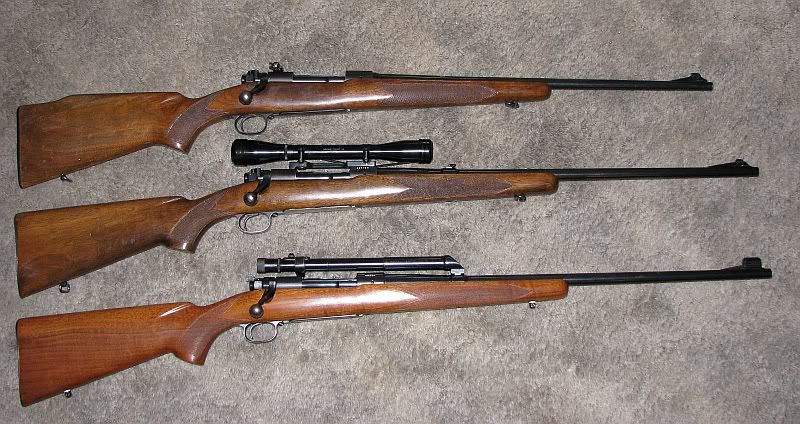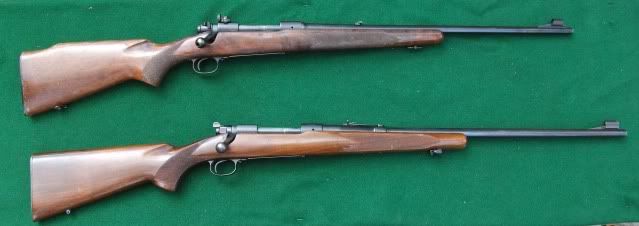You are using an out of date browser. It may not display this or other websites correctly.
You should upgrade or use an alternative browser.
You should upgrade or use an alternative browser.
Difference between winchester M70 featherweight and standard version
- Thread starter STAGE 2
- Start date
Scharfschuetzer
New member
Scorch is correct.
22" v. 24" barrel, barrel without the midpoint bulge and stock screw, aluminium floor plate and trigger guard that loose their anodizing quickly out in the field. While I don't think the stock is any lighter, mine has a higher comb more conducive for scope use than my standard M70. I'm not sure what the weight difference is, but it must be a pound or so. There is no difference in the action, magazine or safety.
22" v. 24" barrel, barrel without the midpoint bulge and stock screw, aluminium floor plate and trigger guard that loose their anodizing quickly out in the field. While I don't think the stock is any lighter, mine has a higher comb more conducive for scope use than my standard M70. I'm not sure what the weight difference is, but it must be a pound or so. There is no difference in the action, magazine or safety.
So the reciever and internals (trigger group, bolt etc) are the same between the two, i.e. if one was to come across a beater featherweight and was interested in a custom build which would result in a new barrel and stock anyways it really wouldn't matter (save the aluminum floorplate).
That's right!So the reciever and internals (trigger group, bolt etc) are the same between the two
Scharfschuetzer
New member
The only difference that you'll find in the actions is the bolt stop (on the bolt oposite the extractor) and the magazines and followers used for the 243 and the 308 versions v. the 30/06 or 270 of the Featherweights. They are easy to replace though if you want to go from a 30/06 length to a 243 or visa versa.
By stopping the bolt sooner with an extended bolt stop, Winchester had in effect a short action for the 243 and 308 Winchester calibres. Perhaps not as eloquent as the later purposely made short actions, but very usable non the less.
By stopping the bolt sooner with an extended bolt stop, Winchester had in effect a short action for the 243 and 308 Winchester calibres. Perhaps not as eloquent as the later purposely made short actions, but very usable non the less.
Last edited:
Scharfschuetzer
New member
Nice Pre-War 70 Slamfire.
Here are my treasures:
1. Featherweight .243 Winchester with Redfield peep sight
2. Post-War 30/06 with Leuopold Pioneer 4X scope and adjustable mount
3. Pre-War .270 Winchester with a 330 Weaver and Korth Mounts

My Featherweight has a plastic or bakelight butplate. It's factory, so I guess we have both aluminium and plastic on the the Featherweights.
I've never seen a standard Pre-64 with an aluminium trigger guard, but now that I've said that, I'll bet someone has.
One and two will shoot MOA while number 3 (Pre-War .270) shoots 1 1/2 MOA for 10 shot groups. I think that is because the Korth mounts have a little play at the objective ring. I'll get 7 or 8 shots under an inch and then 1 or 2 will drop an inch out from the center of the group. That's with Hornady 130 grain interlockt bullets over 4831 powder. I could just shoot the standard 3 shot groups and call it a sub MOA rifle, but larger group size is statistically more accurate.
Funest of the bunch? The .270 with reduced loads.
Most useful? The 30/06 with the 4X scope.
Best for a youth or the wife? The .243. With the peep sight, it is truly a "Featherweight."
Here are my treasures:
1. Featherweight .243 Winchester with Redfield peep sight
2. Post-War 30/06 with Leuopold Pioneer 4X scope and adjustable mount
3. Pre-War .270 Winchester with a 330 Weaver and Korth Mounts

My Featherweight has a plastic or bakelight butplate. It's factory, so I guess we have both aluminium and plastic on the the Featherweights.
I've never seen a standard Pre-64 with an aluminium trigger guard, but now that I've said that, I'll bet someone has.
One and two will shoot MOA while number 3 (Pre-War .270) shoots 1 1/2 MOA for 10 shot groups. I think that is because the Korth mounts have a little play at the objective ring. I'll get 7 or 8 shots under an inch and then 1 or 2 will drop an inch out from the center of the group. That's with Hornady 130 grain interlockt bullets over 4831 powder. I could just shoot the standard 3 shot groups and call it a sub MOA rifle, but larger group size is statistically more accurate.
Funest of the bunch? The .270 with reduced loads.
Most useful? The 30/06 with the 4X scope.
Best for a youth or the wife? The .243. With the peep sight, it is truly a "Featherweight."
Last edited:
gringojosh
New member
I had a Featherweight and found it hard to control. The recoil wasn't painful, but the rifle was jumpy. Shooting lightweight, powerful rifles takes a different skill set.
Scharfschuetzer
New member
When my son was younger, we loaded up 70 grain bullets to about 2,000 fps for him to shoot in the 243 Featherweight. That largly negated the recoil factor for him before he was full grown.
While the 243 is a pretty light kicker, you are right in that a light rifle has more felt recoil. Follow through is pretty important with light weight firearms. Just let the rifle recoil as it wants, then worry about a hit or cycling the action.
While the 243 is a pretty light kicker, you are right in that a light rifle has more felt recoil. Follow through is pretty important with light weight firearms. Just let the rifle recoil as it wants, then worry about a hit or cycling the action.

